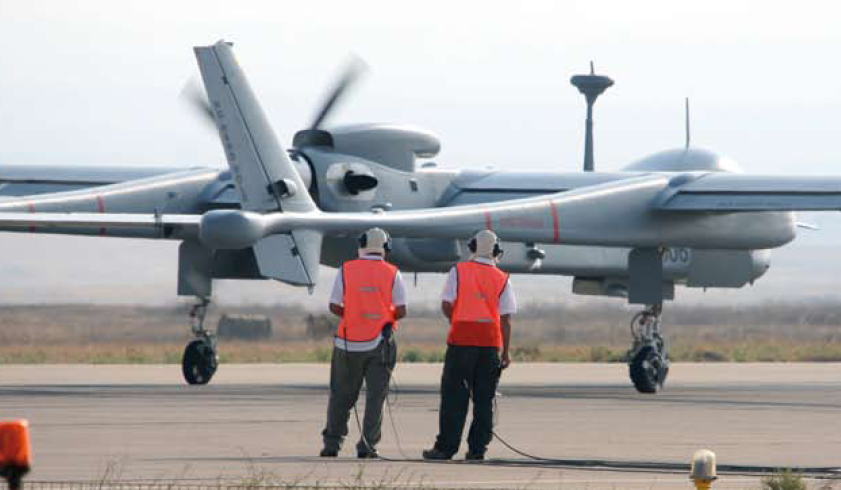For the interim period, an Israeli model is to be leased; over the next ten years, European arms companies are to develop a competitive “Euro-drone”
The German Bundeswehr has now selected a model of combat drone for future use. It plans to lease “three to five” of the latest “TP” version (Block 2) of the Heron family of drones, developed by Israel Aerospace Industries. The prime contractor for the leasing arrangement is the Airbus Group, which entered into a teaming agreement with the Israeli manufacturer on marketing in Europe.
The selection decision is initially a “bridging solution” for a ten-year period. The Federal Government is planning the development by 2025 of a “European solution” for drones which can be armed. After several attempts, the governments of Germany, France and Italy have agreed on a preliminary study for a long-range drone of this kind. The arms companies Airbus, Dassault Aviation and Alenia Aermacchi have been tasked with carrying out this “multilateral drone project”. Spain has since also joined the project.
Airbus was awarded the contract for the bridging solution because the company was also able to secure a role in the “European solution”. The Ministry of Defence believes that this will lead to the development of “real industrial expertise at European companies”. A similar argument had already been put forward by the Inspector General for the Armed Forces: that the choice of the Heron TP, marketed by Airbus, will have a positive impact on the “European drone”. Looking to the future, the Bundeswehr intends to order 16 drones which are capable of being armed from the European companies from 2025.
New deployment in Mali
For the current bridging solution, the Bundeswehr had drawn up and evaluated three “solution options”. According to the Ministry of Defence, “solution option 1” was the Heron TP’s predecessor, the Heron 1, while “solution option 2” was the US system Predator B, which is in use worldwide. The Bundeswehr had attested that the Predator B would face difficulties in gaining certification for German airspace. Criticism was levelled at the US government’s strict rules on the release of key documents which would be needed for certification procedures for the Predator B. The Israeli government reportedly takes a less restrictive approach in this regard. Since 2011, the Bundeswehr’s competent divisions had travelled to Israel on several occasions for “discussions on certifiability”. The arms company Airbus also participated in an “intra-company” assessment.
Three unarmed Heron 1 drones are already being used by the Bundeswehr in Afghanistan. The new Heron TP drones would not be available until two years from now; for this reason, it is possible that the old leasing agreements for the Heron 1 will initially be extended. At the same time as the selection decision, the Minister of Defence announced plans for the deployment of unarmed drones in Mali. Heron 1 drones could be flying in Malian airspace as early as the autumn of this year, with negotiations already under way.
It is unclear where the new drones would be stationed. They were foreseen to be allocated to the Tactical Air Force Wing 51 in Jagel, Schleswig-Holstein, where a military airfield has already been converted. However, since the drones require special authorisation to fly in Germany, it is conceivable that they could be temporarily stationed in Israel. From there, they could be deployed to their operating areas; it would also be possible for training to take place there.
The selection decision for the bridging solution is tied to further requirements relating to certification and weapons integration. Although the Bundeswehr intends to procure the newest version of the Heron TP, the system is not fully mature. It recently came to light that the British intelligence service has intercepted the Israeli drones’ data link and even recorded video. Germany’s Ministry of Defence therefore intends to engage in renegotiations about the Heron TP’s communications system and encryption methods.
Bombs and missiles are referred to as “air-to-ground weapons”
In talks with arms companies, the specifics of arming the drones are now on the agenda, with the first details expected to be established by June. According to the Ministry of Defence, the drones would be equipped with “self-propelled and non-self-propelled air-to-ground weapons”. This refers to guided bombs or missiles, which seek their targets using GPS coordinates. Target designators could also be fitted. These are systems that use a laser to mark targets, which can then be bombed by other aircraft or drones.
The Federal Government had promised a “public debate” before the procurement of combat drones. The 2013 coalition agreement between the SPD and the CDU stated that the Federal Government intended to “carefully examine” all questions of international and constitutional law, security policy and ethics relating to combat drones. The examination was, however, reduced to a hearing in the Bundestag lasting several hours and the subsequent plenary debate, with the outcome being summarised as “still controversial” even by the Bundestag.
Image: Israeli drone Heron TP (all rights reserved IAI).




